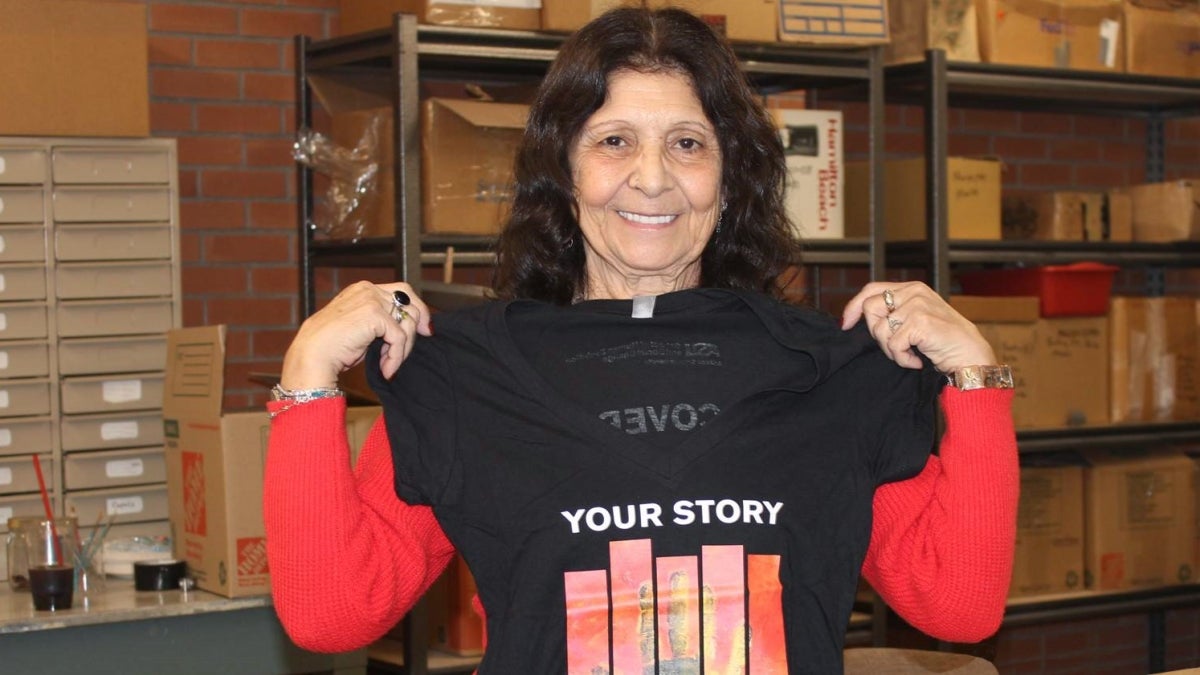ASU retiree becomes ASU graduate

Gina Deane in one of the school’s labs, holding up a School of Human Evolution and Social Change T-shirt she won.
Editor's note: This story is part of a series of profiles of notable fall 2020 graduates.
Gina Deane celebrated her retirement in an unconventional way — by pursuing a college degree.
Deane held an incredible variety of roles during her career. The former clinical psychotherapist, IT manager and soon-to-be archaeologist advocates “just exploring.” After her most recent position at Arizona State University’s Business Technology Services, where she worked for 21 years, she decided it was time to pursue a passion she’s always had — archaeology.
The Phoenix native is graduating in December with a Bachelor of Arts in anthropology from the School of Human Evolution and Social Change.
She didn’t want the transition from work to retirement to feel too abrupt, so she worked part time as a grocery store bookkeeper while taking archaeology classes.
Having worked two decades at ASU, Deane said, “it’s a good place to work, and an even better place to get an education.” She frequently encouraged her staff to continue their education and personal development at the university.
As an anthropology student, Deane was involved in several of the school’s Undergraduate Research Apprenticeships. In fact, she’s spent so much time in the Teotihuacan Research Lab that she calls it her home away from home.
Now, she eagerly awaits planned trips to Mexico. After assisting with projects in the lab on campus for two years, Deane is looking forward to visiting the Teotihuacan site. She also is planning to help with an archaeological survey in Mexico with a postdoctoral scholar.
A positive attitude is apparent in this life-long learner, complementing her mantra, “life is what you make of it, friend.”
She shared more about her research and studies at ASU.
Answers have been edited for length and clarity.
Question: What was your “aha” moment, when you realized you wanted to study the field you majored in?
Answer: I had my “aha” moment when I was just a girl. I watched a documentary on Louis Leakey and his discoveries in Olduvai Gorge, Ethiopia. I was hooked. Even though my career paths took different directions, I never lost my passion for archaeology. As retirement approached, I decided I was going to go for my degree and devote the next chapter of my life to my passion.
Q: What’s something you learned while at ASU — in the classroom or otherwise — that surprised you or changed your perspective?
A: I didn’t think returning to school at my age would be easy, but I found there were several classes I took that really surprised me. I was required to take English, algebra and a language. But, it was part of my curriculum and I persevered. Also, the young students were very accepting of me which was a bit of a surprise. I figured they’d probably have some fun at my expense, but they didn’t. In fact, I made quite a few friends with the younger students.
Q: Why did you choose ASU?
A: I chose ASU for its outstanding reputation as a Research 1 institution and for its stance on issues of inclusion and acceptance. Also, having worked for ASU, I knew the curriculum would be first class all the way.
Q: Which professor taught you the most important lesson while at ASU?
A: Many professors have given me great advice and assistance, and taught me what it means to be an archaeologist: Professor Michael E. Smith, Postdoctoral Research Associate Angela Huster, who is also my mentor, Assistant Research Professor Melissa Powell and Associate Professor Christopher Morehart. I’ve worked as an intern for both Smith and Huster for two years in the Teotihuacan Research Lab at SHESC. I’ve learned so much about “Teo,” as we call it, by updating databases, digitizing discovered artifacts and listening to the researchers' adventures.
While spending two semesters interning with Powell, I learned about curatorship of the artifacts, cataloging and sorting, and general museum ethics and practices.
Morehart has given me the opportunity to view an excavation through the lens of his camera by organizing his excavation photos from his North Mexico Basin site. These experiences have made my education well-rounded and now I feel I can be an asset on any excavation site — surveying, excavating, cleaning, cataloging or sorting.
Q: What’s the best piece of advice you’d give to those still in school?
A: If you’re passionate about something, go after that degree! If I can do it at my age, you can do it at your age.
More Arts, humanities and education

Honoring innovative practices, impact in the field of American Indian studies
American Indian Studies at Arizona State University will host a panel event to celebrate the release of “From the Skin,” a…

ASU alum's humanities background led to fulfilling job with the governor's office
As a student, Arizona State University alumna Sambo Dul was a triple major in Spanish, political science and economics. After…

ASU English professor directs new Native play 'Antíkoni'
Over the last three years, Madeline Sayet toured the United States to tell her story in the autobiographical solo-…